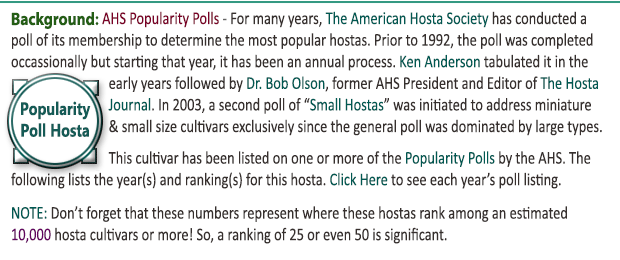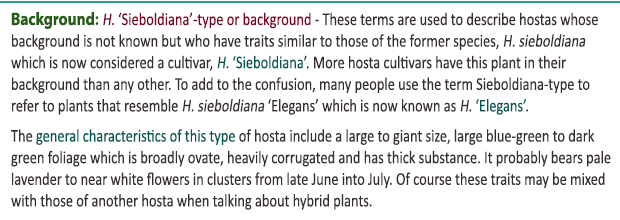|
  The American Hosta Society originally registered this slow growing plant as Hosta tokudoma
'Flavo-circinalis' in 1987. In his book,
The Genus Hosta
by
George Schmid (1991) determined that this plant was actually a cultivar and not a
species. He gave it the current name of Hosta 'Tokudama
Flavocircinalis'.
It was first described by
Dr. Fumio Maekawa in Japan around 1940. The American Hosta Society originally registered this slow growing plant as Hosta tokudoma
'Flavo-circinalis' in 1987. In his book,
The Genus Hosta
by
George Schmid (1991) determined that this plant was actually a cultivar and not a
species. He gave it the current name of Hosta 'Tokudama
Flavocircinalis'.
It was first described by
Dr. Fumio Maekawa in Japan around 1940.
This medium size (17 inches high by 48 inches wide) hosta has gold marginal
variegation with dark blue-green center. The leaves are oblong to ovate,
slightly cupped, wavy and
heavily corrugated. Its thick leaf substance makes it resistant to
slugs. This plant has near white flowers that bloom from late June into
July followed by viable seeds.
 According to
The Hostapedia by
Mark Zilis (2009), this cultivar "...ranks highly
amongst all hosta cultivars and is considered a classic. It
makes a great specimen plant or ground cover and has a faster
growth rate than most Tokudamas. The gold edge of 'Tokudama
Flavocircinalis' does not burn in the spring, so it can be used
as a substitute for 'Frances
Williams'. According to
The Hostapedia by
Mark Zilis (2009), this cultivar "...ranks highly
amongst all hosta cultivars and is considered a classic. It
makes a great specimen plant or ground cover and has a faster
growth rate than most Tokudamas. The gold edge of 'Tokudama
Flavocircinalis' does not burn in the spring, so it can be used
as a substitute for 'Frances
Williams'.
The New Encyclopedia of Hostas by
Diana
Grenfell (2009) states: "Slow to increase...A classic hosta which does not
scorch at the leaf margins."
This cultivar has been sold under the Trademark name Hosta
HAPPY HIPPO™.

 An article about H. tokudama 'Flavocircinalis' by Warren I. Pollock in
The
Hosta Journal (1985 Vol. 16) states that, "...means
"coiled with yellow."..." An article about H. tokudama 'Flavocircinalis' by Warren I. Pollock in
The
Hosta Journal (1985 Vol. 16) states that, "...means
"coiled with yellow."..." In
The
Hosta Journal (2001 Vol. 32 No. 1),
Tom Micheletti,
former President of The American Hosta Society took on the task of listing the
"Classic Hosta Cultivars" through the year 2003. He decided to divide these into
categories including: Green,
Blue,
Yellow (Gold,
White-Margined,
Yellow-Margined,
White Medio-Variegated
and Yellow Medio-Variegated.
| While there are fewer yellow-margined
hostas, there are still some timeless beauties. |
| Classic
Yellow-Margined Hostas |
- H. 'Abiqua Moonbeam' is the green-centered sport of H.
'August Moon' and surely shines in the garden.
- H. 'Alvatine Taylor' is a large blue-leaved hosta with gold
margins that don't exhibit the characteristic burning of
gold-leaved forms of
H. 'Sieboldiana'.
- H. 'Aurora Borealis' is one of the many similar cultivars in
this group. H. 'Frances Williams' has been one of the most
imitated of the classic hostas, after all she was the first of
over a dozen named, similar gold-margined sports from H. 'Elegans'
. Each one is reported to be an
improvement. Claims include not burning as much on the gold
portion of the leaf, improved flowering or showier variegation.
In any case, it is difficult to distinguish these cultivars.
- H. 'Carnival' is a
Lachman hybrid which features dark-green
leaves and wide irregular gold margins.
- H. 'Don Stevens' has pointed green leaves with creamy-yellow
margins.
|
- H. 'Fortunei Aureomarginata' is an oldie that still is not
to be outdone with its dark-green leaves and golden margins.
- H. 'Golden Tiara' has produced a whole series of sports, as
previously noted, one of which is H. 'Grand Tiara' with wider
gold margins. H. 'Grand Tiara' also has produced a whole series
of sports. The Tiaras all have a fine display of light-purple
flowers that may re-bloom if deadheaded.
- H. 'Green Gold' is one of the early gold-margined hostas.
- H. montana 'Aureomarginata' - as showy as it gets!
- H. 'Radiant Edger' is a dense sport of
H. 'Gold Edger' has
an attractive blend of green with gold.
- H. 'Tokudama
Flavocircinalis' is the gold-margined sport of
H. 'Tokudama' and while not as large as
H. 'Frances Williams',
doesn't exhibit the typical burning of the gold margins.
|
|
This is quite an extensive list of
distinctive cultivars. Many have been popular either with gardeners,
landscapers and collectors for over 25 years...Their timeless beauty
is why they are still kicking after all these years. |
| |
|
 An article by
Warren I. Pollack in
The
Hosta Journal (2020 Vol. 51 No. 1) titled
Doppelgänger Hostas: Fancy Name for
Look-alike Hostas, included a long list of hostas
which various hostaphiles, published articles or other sources have
indicated "look" the same. Some of these are, in fact, the same
plant with two or more different names. Others are hostas that vary
in some minor trait which is not immediately discernable to the
casual observer such as seasonal color variations, bloom traits, ploidy, etc. So, as Warren mentions, hostaphiles may differ as to the
plants listed but then, their opinions are based on visual observations and interpretations. An article by
Warren I. Pollack in
The
Hosta Journal (2020 Vol. 51 No. 1) titled
Doppelgänger Hostas: Fancy Name for
Look-alike Hostas, included a long list of hostas
which various hostaphiles, published articles or other sources have
indicated "look" the same. Some of these are, in fact, the same
plant with two or more different names. Others are hostas that vary
in some minor trait which is not immediately discernable to the
casual observer such as seasonal color variations, bloom traits, ploidy, etc. So, as Warren mentions, hostaphiles may differ as to the
plants listed but then, their opinions are based on visual observations and interpretations. |
| |
 H.
HAPPY HIPPO and
H. 'Tokudama
Flavocircinalis'. H.
HAPPY HIPPO and
H. 'Tokudama
Flavocircinalis'. |
|
 |

 |
 |
 |
 |
| 7 |
18.3 |
1985 #24
1990 #17
1991 #14 |
1992 #14
1993 #19
1999 #25 |
2002 #15 |
|
|
|
|





|



